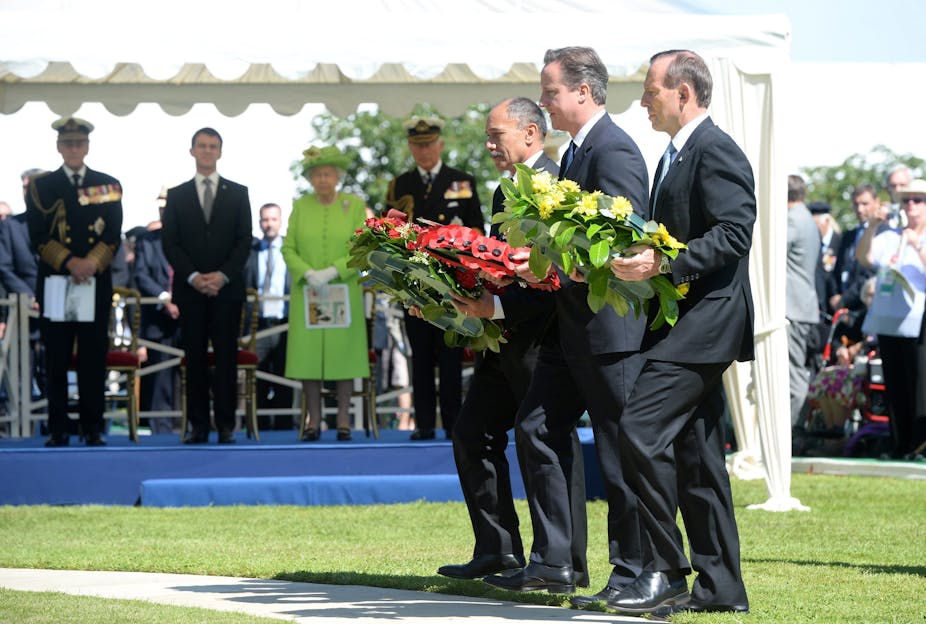When prime minister Tony Abbott declared at Villers-Bretonneux that “no place on earth has been more densely sown with Australian sacrifice than these fields in France”, Australian attention focused again on the battlefields of Europe as a source of national inspiration.
Abbott pledged that Villers-Bretonneux would host an interactive museum, the centrepiece of the Australian Remembrance Trail stretching from Ypres in Belgium to Peronne in France, by 2018 as part of an estimated A$140 million in government funding allocated to the Anzac centenary.
This investment shows the importance the Australian government attaches to making the Great War accessible and comprehensible, linking Australians to people and places on the other side of the world.
So, as we approach the centenary of the outbreak of the First World War, who or what is shaping the way we remember it?
The wave of events, reports, films, exhibits, books, television programs, research projects and many other contemporary forms of First World War commemoration is well underway. Significant anniversaries proliferate at this time of year, such as June 28, the date that Franz Ferdinand was assassinated, and August 4, when German troops invaded Belgium, and Britain (and therefore the Empire) declared war.
These dates are not just important for historians. As the surge in commemorative activity shows, the First World War is very much a contemporary phenomenon – one that pulls in dozens of countries.
In a recently released book we co-edited, contributors discussed the politics shaping First World War commemorations in the United Kingdom, New Zealand, France, Germany and Belgium in order to better understand Australia’s commemorations in a comparative framework.
The first point to note is that these commemorations are global in nature. Similar pressures to create new narratives linking globalised states and national citizens generated demands for commemorative activity across the developed world in the past 30 years. Australia is no exception. The Great War commemorations take place at what might be the zenith of the current “memory boom”.
A second finding is that despite common global themes (and maybe because of them), national and local circumstances loom large in the form and content of Great War commemorations.
Such activities are not organised in a political vacuum. They are performed with the crucial support – or at least the inevitable intrusion of – the state. Official organisation of commemorative ceremonies, government funding for memorials and education programs and the language our political leaders use all shape our remembrance of the Great War.
This means that the themes and tones of commemorations must resonate at a personal as well as national level, and be politically useful in order to continue to enjoy official support.
A related point is that the use of “memorial diplomacy” is increasing as part of this trend and as a deliberate activity of government. Abbott’s attendance at D-Day remembrance ceremonies in June, along with leaders from the UK, France, Britain and Germany (among others), is a recent example. Such co-operative, multinational activity affects the tenor of domestic commemoration, but will also be an important stage for bilateral and multilateral relationships up to 2018.
As we know, remembering and forgetting are two sides of the same coin. But something else has become apparent in the run-up to the centenary: it has become extremely difficult – if not impossible – to remember the First World War without remembering the Second World War. This has been particularly the case in Germany but is no less true in Belgium. It is also difficult to imagine the Great War in Ireland, north and south, without memories of “The Troubles” intruding.
This blending of histories has its origins in specific national memories. In Germany, it occurs because the crimes of the Holocaust have permanently coloured German views of the entire 20th century. It exists in Belgium because accusations of Flemish collaboration with the Nazis are used to delegitimise Flemish nationalism. In Northern Ireland, there are direct organisational links between the nationalist and loyalist paramilitaries operative until the peace of 2007 and the civil wars fought in Ireland from 1916.

Finally, despite recent historical research stressing the transnational nature of the First World War, contemporary commemorative politics remain national despite, and also because of, its global scope. This is a very basic point but one that needs stating. The politics of nationalism has a profound impact on the shape of Great War commemoration.
In some places, nationalist politics may prevent a deep connection with state narratives, as happens in Flanders in relation to the rest of Belgium. In other multinational states, such as the United Kingdom, the politics of nationalism and multiculturalism produce state narratives that seek to include an almost impossibly wide national and international group of communities.
In France and Australia, where more unitary national narratives exist, commemoration provides an opportunity for governments to endorse values they hold dear.
Although widely blamed for the outbreak of war and for playing a large part in sustaining the conflict once hostilities began, nationalism still plays an important part in the way that the First World War is remembered today. No matter how great the toll, it is clear that the “nation” was not on the casualty list.
So, who owns the national myth as it relates to the Great War? The answer in Australia and Europe is that there are many players with vested interests – from individuals to organisations to governments. But some are more equal than others in shaping the way we remember the First World War, and even in a global era the self-weakened state still plays a dominant role in how and what we commemorate.
The example of the Australian Remembrance Trail reminds us that even when governments seek to do less and ask citizens to do more “lifting”, a compelling national narrative is not something they can do without.
This is the first piece in The Conversation’s Commemorating WWI series. Stay tuned for others in the days to come.

